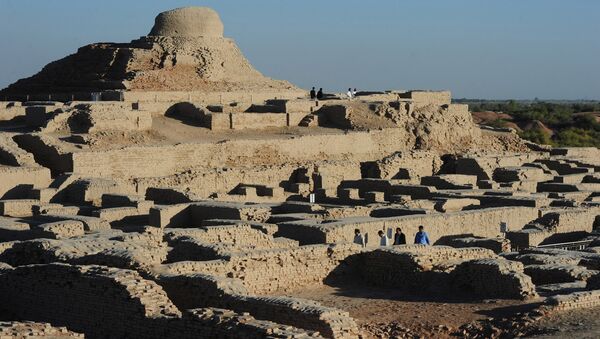In 1920, a team of archeologists found a flint in Pakistan that dates back further than some of the country's oldest and most revered religious shrines. Over a period of about 50 years, large scale excavations uncovered a 5,000-year-old city in the South of the country, which included street grids and a complex drainage system. The city was branded "Mohenjo Daro," which translates to "mound of the dead" in Sindhi.
Researchers desperate to save lost city of #MohenjoDaro and let it claim its rightful place in #history. https://t.co/WVUtSTUMSm pic.twitter.com/P44tRDnGf2
— Ancient History (@ahencyclopedia) May 18, 2017
As it stands, not a great deal is known about the city or its former inhabitants, not to mention having no clue of its original name. There are no remains of places or religious shrines that could indicate the age in which the city was alive. According to determined archeologists, the city likely had its heyday in 2500 BCE but, after suffering cataclysmic events like powerful weather storms and unrelenting drought, it ceased to be by 1900 BC. However the precise cause of the city's decimation, remains a scientific and archeological mystery.
Pakistan's ancient citadel of #MohenjoDaro will disappear unless steps are taken to preserve it, archaeologists say https://t.co/EnrHOdt95x pic.twitter.com/EUExyeX2pX
— AFP news agency (@AFP) May 16, 2017
In order to find out more, those archeologists working on the site will need to dig deeper. However, preserving the history of Mohenjo Daro has its complications. While digging up more ruins could provide the key to unlocking the mystery at the heart of the ancient Indus Valley civilization, there are concerns that excavating the city could make it vulnerable to decay and damage.
The major surges in heat is one issue. In the summer, temperatures in the area can reach over 46 degrees Celsius. Exposure to such heat while out of the ground, it is feared, could rupture the structures of the city and cause an irreversible crumbling affect.
Archaeologists warn Pakistan's ancient citadel of Mohenjo Daro will disappear unless steps are taken to preserve it https://t.co/EnrHOdbxGX pic.twitter.com/61kIJOMoSs
— AFP news agency (@AFP) May 16, 2017
The other concern is a bit more familiar to the average newsreader. Pakistan's government and its neighboring states continue their war against Islamic militancy, the concern is that groups such as Daesh could, as they have done in Palmyra in Syria, destroy such sites. The group claims that pre-Islamic iconography is idolatrous, thus a sin.
The biggest cause of damage however, is us. Ordinary citizens going on trips to the ancient city are dropping litter around the site, and showing little care for its delicate and fragile remains. For example, in February 2014, those participating in the setting up of the Sindh Festival trampled all over the site and set up stages and tents, hammering them into the friable remains.
In order to avoid the aforementioned, the archeologists working on the site have aid that further excavation should be abandoned, and instead it should be buried until a better method of preservation is found. "It is actually preserved when it is buried," Harvard University's Dr. Richard Meadow is quoted as saying.




